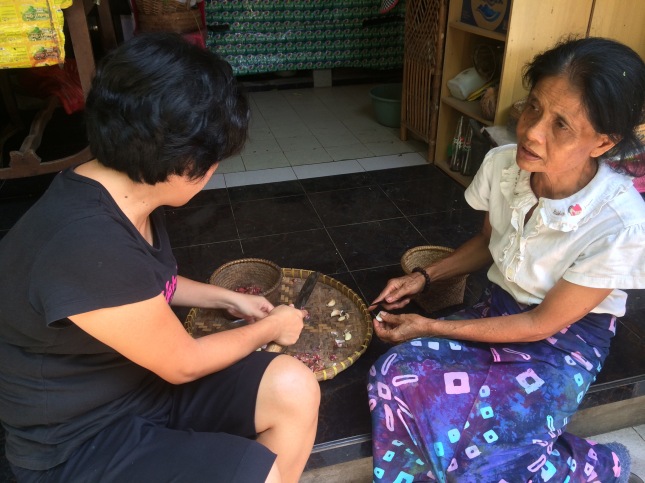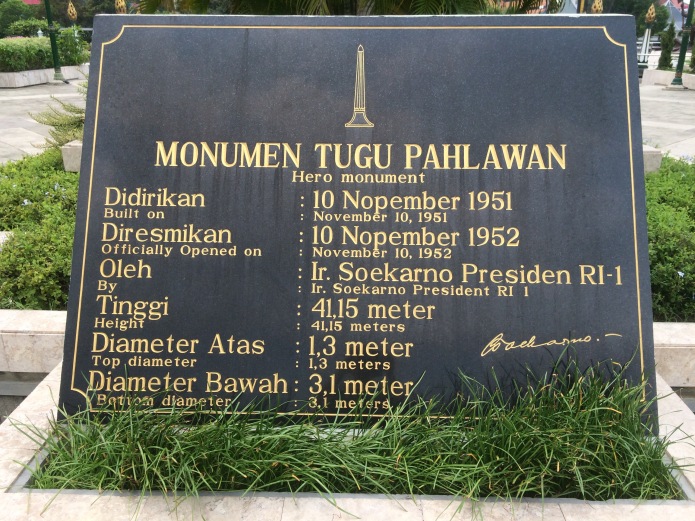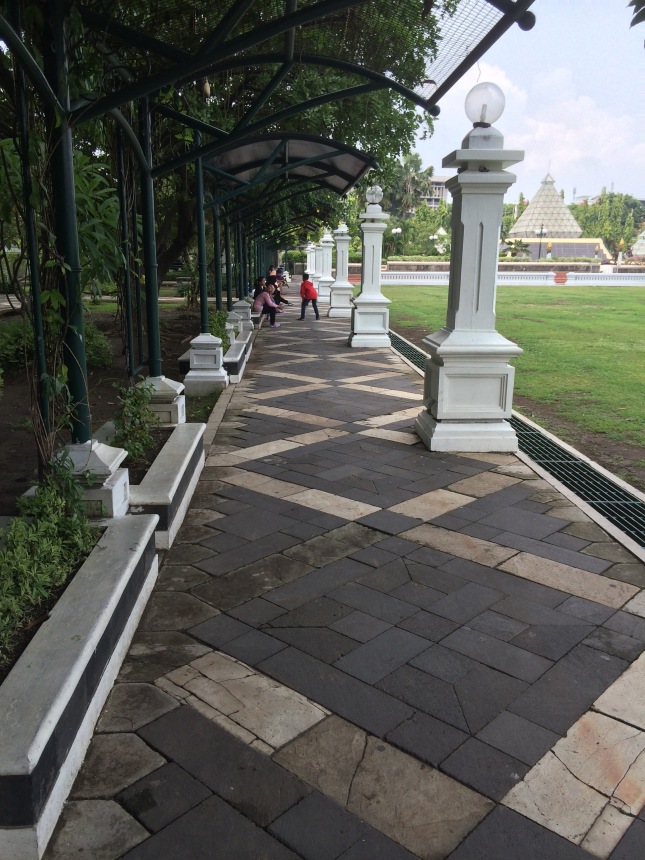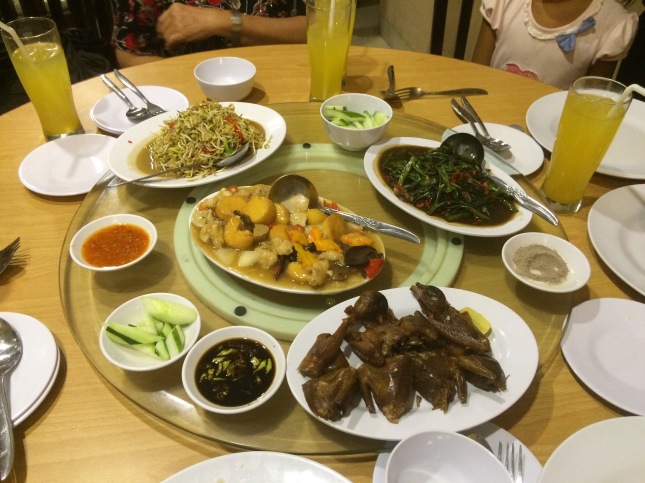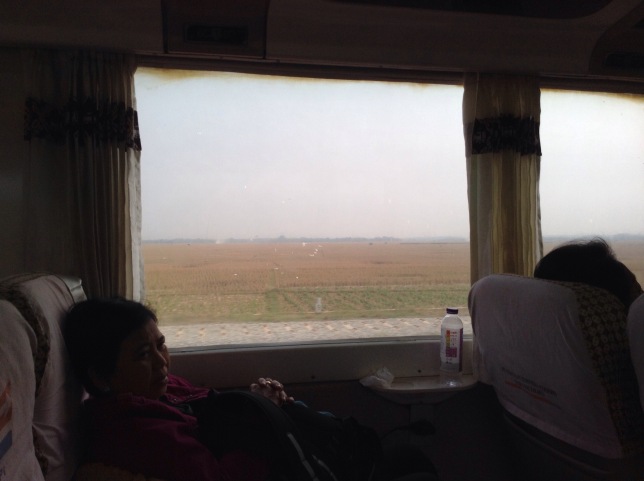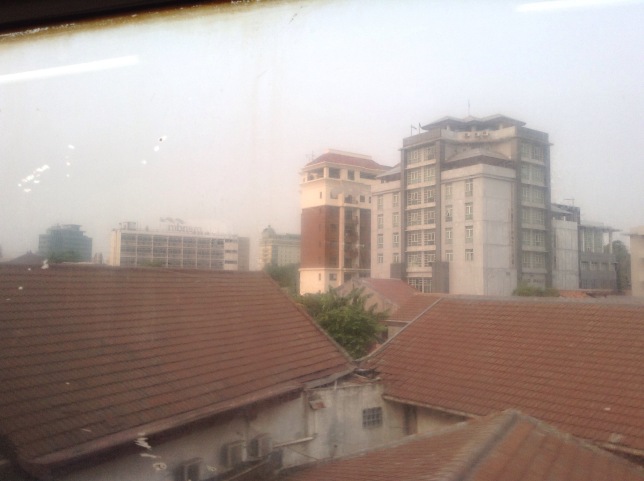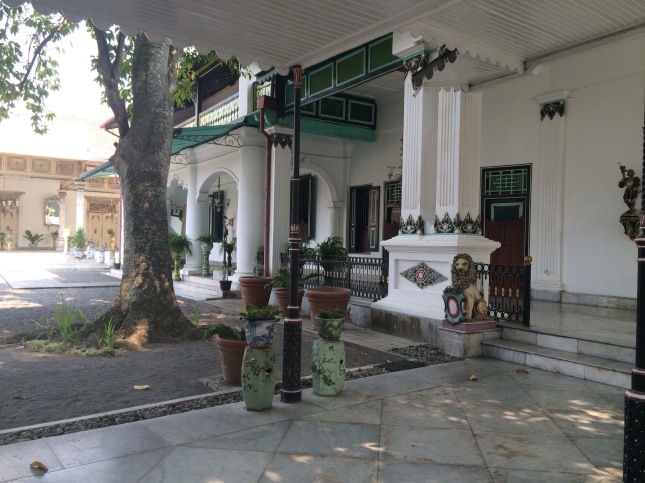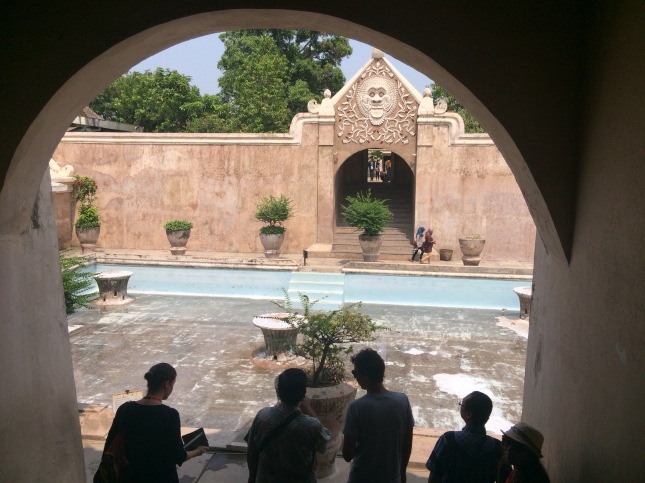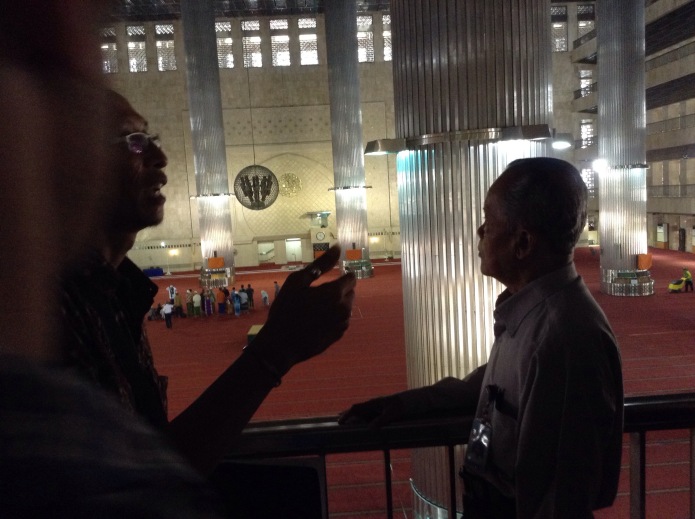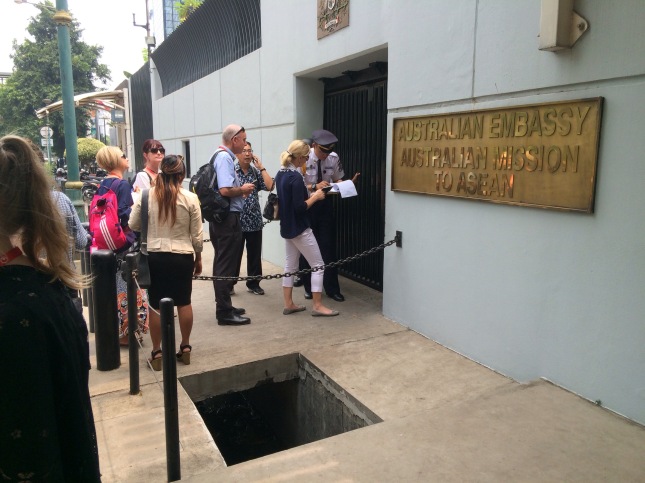Jan 1st, we spent traveling. It felt as though we spent the entire day sitting. Firstly at the airport where our plane was delayed
 and then in Bali where our baggage took forever to hit the carousel and then in the car to our respective hotels where we managed to hit rush hour. It was 8pm before Lenny finally reached her hotel because after dropping me off at my hotel, she had to head back to the airport to meet her husband, Henry, who had flown in from Jogykarta to rejoin the family for the final leg of their holiday.
and then in Bali where our baggage took forever to hit the carousel and then in the car to our respective hotels where we managed to hit rush hour. It was 8pm before Lenny finally reached her hotel because after dropping me off at my hotel, she had to head back to the airport to meet her husband, Henry, who had flown in from Jogykarta to rejoin the family for the final leg of their holiday.
While I had hoped to stay again at the Bakung Sari Hotel while in Kuta, their prices have gone through the roof being high season, so instead I am staying at the Jesen Inn 2, which is in the gang (alley/lane) next door. I just love this area of Kuta because if you walk north to Jln Bakung Sari, you are in tourist Kuta and if you walk south to Jln Kubu Anyar, you are in the more Balinese part of Kuta. On Jln Kubu Anyar, you can buy nasi bungkus for Rp12,000 but on Jln Bakung Sari, the food options are more tourist oriented. I did follow an elderly lady pushing her bike and ringing the bike bell down Jln Bakung Sari late yesterday afternoon selling her nasi bungkus to the locals working in the salons and various other tourist shops. I did not buy it from her though because waiting back in my room was nasi lawar complete with one of those delicious fish sate cooked on a flat Bamboo stick. (What are they called, Dad?) It always amuses me that back in Australia, rice is never left out of the fridge for long, yet in Indonesia, nasi bungkus can be assembled at home, transported to where it will be sold and it will then sit for who knows how long before being sold. The fellow selling nasi lawar yesterday, looked as though he’d only just arrived because his bowl of rice was still quite full. Still, I had no reservations about leaving my nasi bungkus in my room while I popped out to do some jobs and have a swim! The nasi lawar and swim were a lovely way to finish my last day with Lenny and her family, before I head to Jimbrana to spend the rest of my time here in Bali with my friend, Kadek.
I was collected by Lenny around 9:30am and finally got to see Henry again. He was flanked by both children who were thrilled to see him again! The drive to Mas took us via Sanur where as usual, I saw many changes. A huge intersection just out of Sanur with a Ramayana statue was one! We were heading to Mas to join Ayu, Wahyu and their son Nanda for lunch at Wahyu’s parents house. While Ayu and Wahyu are both living and working in Surabaya at the moment, and Nanda is going to school there, it was great that we all happened to be in Bali at the same time. My sister too had been invited but sadly it was the very day she was flying home to Australia. It would have been brilliant had the timing been better.
Our driver had difficulty locating their house which isn’t too surprising as once we left the main road, there were no sign posts. We called Wahyu and his father drove out on his motor bike to lead us back to their house which we’d passed.
Wahyu’s parents house is in a typical Balinese style compound where several family members can live together. After being introduced to Wahyu’s parents who greeted us out the front, we entered their walled family coumpound through a decorative gate. Immediately to our right was the kitchen while to our left was a large balai (open building used for entertaining friends/family or just relaxing). This balai is the larger of the 2 in this compound and it was a hive of activity. Men were busily constructing a sign and various other structures for a wedding package order. Also in the balai were 2 women decorating glass jars which would hold flowers at the wedding reception. It was quite frantic because the wedding was the following evening! Where ever we looked were items for the order. Buckets and buckets of white roses and gypsophila which had been shipped in from Bandung, tied bundles of decorative looking drift wood, sliced chunks of wood that look more to me like traditional mortars (& pestles), carved bamboo looking poles as well as other trendy stuff that will hopefully be recycled!
We headed passed them all working flat out after saying hello and were invited to sit in the smaller balai which was set up like a sitting room. There was a carpet square on the floor, a sofa and a tv against one wall as well as a fridge against the other wall! Balai’s traditionaly are open on 2 sides and walled the other 2 and are always the coolest place to sit during the middle of the day. Immediately after the 5 of us sat down, we handed our oleh-oleh to Ayu who immediately put it all aside and then placed on the carpet a bowl of broad bean snacks and a tray with glasses and pineapple juice. We talked briefly with Ayu and then Wahyu joined us. He had been resting as wasn’t feeling very well.
Suddenly Ayu was called by Wahyu’s mum to help take the food out to the table in the garden where there was a lawned area perfect for eating al fresco. Lenny then asked whether there was sambal mentah (uncooked chili sambal). Wahyu’s mum turned to Ayu and Lenny and said defensively, “I wasn’t told I had to make that too!” We laughed at the typical Balinese response! While pretending to be gruff, she was actually thrilled we asked for it and we were given an impromptu lesson on how to make it.
1. Peel a large number of garlic and eschallots.

3. Add finely sliced kaffir lime leaves and cabe rawit (tiny spicy chili)
5. Mix everything together and serve.
It was then carried out to the table and we were all invited to eat. Ayo makan, makan!
 I did not take much convincing and enjoyed the urap (vegetables with coconut), tempeh and over my rice the kuah (liquid) from the ayam betutu
I did not take much convincing and enjoyed the urap (vegetables with coconut), tempeh and over my rice the kuah (liquid) from the ayam betutu
 which is a traditional Balinese dish and saying that it is chicken cooked in spices, which it is, just doesn’t do it justice. The meal was simply delicious and sitting out in the cool garden chatting together was so lovely.
which is a traditional Balinese dish and saying that it is chicken cooked in spices, which it is, just doesn’t do it justice. The meal was simply delicious and sitting out in the cool garden chatting together was so lovely.
 Again typically, at the table was just Lenny, Henry, Ayu, myself and Wahyu. The children ate in the balai and the other adults waited until we had finished eating before helping themselves to the dishes. While we sat there patting our full bellies, Ayu served a dish called, I think, coco de coco. It is a clear sweet drink full of white cubes of a firm jelly consitency enjoyed from a glass with a spoon. So refreshing. We mentioned that we had passed Pasar Sukawati and before long we had said our goodbyes and thankyous to Wahyu’s parents were in 2 cars heading to Sukawati with everyone except Wahyu who no doubt fell back into bed!
Again typically, at the table was just Lenny, Henry, Ayu, myself and Wahyu. The children ate in the balai and the other adults waited until we had finished eating before helping themselves to the dishes. While we sat there patting our full bellies, Ayu served a dish called, I think, coco de coco. It is a clear sweet drink full of white cubes of a firm jelly consitency enjoyed from a glass with a spoon. So refreshing. We mentioned that we had passed Pasar Sukawati and before long we had said our goodbyes and thankyous to Wahyu’s parents were in 2 cars heading to Sukawati with everyone except Wahyu who no doubt fell back into bed!
Being New Year, it was packed with domestic tourists. We followed Ayu to a stall run by their neighbour. Lenny bought all her oleh oleh (souveniers) there while I bought 2 lengths of material I hope to have made into sarongs that tie up with just a button rather than a knot which I much prefer these days. While Lenny was busy selecting her oleh oleh, I passed the time chatting to a fellow shopper who comes from Kalimantan Timor. She was on holiday in Bali with her friend who is a primary school maths teacher. I also enjoyed listening to Lenny & Henry’s son telling his life’s story in Indonesian to a seller in the adjacent stall. It was hilarious. The adults listening were all in stitches. He told them all the story of how how Lenny & Henry met in Australia, where they had lived in Australia and when and why they had moved. Tsen loves talking and with a captive audience, he was in 7th heaven. If anyone tried to interrupt him with questions, he would dismissively answer and then return to his story. They were curious about my connection with his family but any questions about me where irrelevant and answered briefly before resuming his story from the exact point he’d been at when interrupted! It was absolutely lovely listening to both Lenny’s children and Ayu’s child who are all fluent in the languages spoken by their parents. Tsen and Meme speak Indonesian, Javanese, Mandarin & English while Nandu is fluent in Javanese, Balinese, Indonesian and is also learning English.
Before heading back to the cars, we crossed the road to buy kebaya, the traditional shirt that is worn by women with a sarong. I bought a blue one already made and the material for a white one, which again I hope the tailor near Kadek’s has the time to sew up for me.
The drive home went very quickly with a brief visit to the widow of Lenny’s father’s close friend and before I knew it, the driver had reached the top of Jln Kubu Anyar where I insisted I was set down because the traffic was worsening rapidly. When that bad, it is quicker to walk than to drive! I said a very quick thank you and goodbye to everyone before they drove off to Benoa where they are staying. It felt so strange not making plans for the following day. It has been so lovely spending time together after not seing each for such a long time.
Thank You Lenny for allowing me to tag along with you and your family for this past week. I loved every single minute of it! Look forward to traveling with you again one day! Where shall we meet next time? Jogjakarta? Bandung?

